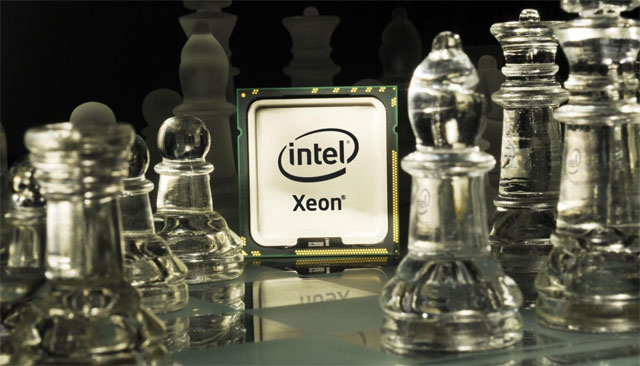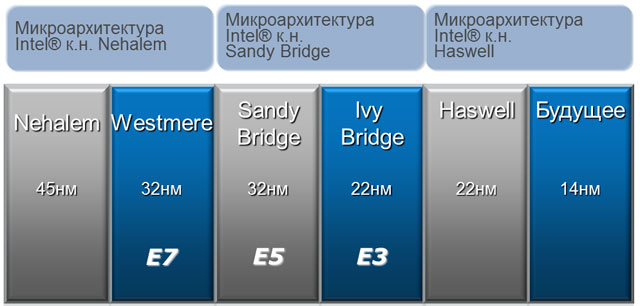Intel Xeon processors. Lineup "Spring - Summer 2013"

It is difficult to imagine a concept more related to Intel than a processor. At one time, having a hand in the appearance of this class of devices in the mass market, Intel is now spending no less effort on their continuous improvement. As a result of these titanic efforts, there is a regular generational change of processors: probably everyone knows about the tick-tock. Let’s, however, fix the picture and look around the entire processor lineup - by what principle is it built? Let's start with the Intel Xeon server processors.
The Intel Xeon line dates back to Pentium II. Historically, they were built on the same microarchitectures as desktop processors with the addition of specific server features, such as support for multiprocessing, an increased cache, support for an extended set of instructions, etc. If we talk about the current Xeon'ah from the point of view of the platform, it turns out pretty interesting picture.

However, if you think about it, the situation when the three Xeon families are so scattered across the Intel technology line does not seem strange. Server processors are much more complex than desktop ones; it takes a long time to develop and implement those very specific features, and the more of them, the longer. That is why the simplest E3 “jumped” farthest; with them we will begin the analysis of Xeon by family.
Intel Xeon E3
The current Intel Xeon E3 line is represented by the E3-12xx v.2 models (note v.2, v.1 were built on Sandy Bridge). Their main purpose is budget single-socket servers, as well as embedded systems that are not too demanding on the computing resource. In the lineup there are models with reduced power consumption (they have an L index), a little apart is the super-energy-efficient model E3-1220L , slaughtered in all respects, we will exclude it from a further review.In general, the picture looks like this. Processors E3-12xx v.2 have a frequency from 3.1 to 3.7 GHz, 4 cores and hypertreading (with the exception of the younger 122x models - they are without hypertreading). All have 8 MB cache, Turbo Boost support. There are two memory channels, the frequency is up to 1600 MHz, the maximum volume is up to 32 GB. Processors with a five on the end have an integrated graphics core Intel HD Graphics P4000 (the model E3-1265L has Intel HD Graphics 2500). All processors support VT-x / VT-d virtualization technologies, Trusted execution, and the latest version of SpeedStep. For greater clarity, we draw a summary plate of the main parameters for three processors from different ends of the line. You will find the full comparative table on the well-known site ark.intel.com .
| E3-1290 v2 | E3-1270 v2 | E3-1220 v2 | |
|---|---|---|---|
| Clock frequency, GHz | 3.7 | 3.5 | 3.1 |
| Frequency with Turbo boost, GHz | 4.1 | 3.9 | 3.5 |
| Number of cores / threads | 4/8 | 4/8 | 4/4 |
| Cache, MB | 8 | 8 | 8 |
| Max. amount of memory GB | 32 | 32 | 32 |
| Number of memory channels | 2 | 2 | 2 |
| Max. calc. Power, W | 87 | 69 | 69 |
| Reference point. cost, $ | 885 | 328 | 189 |
Intel Xeon E5
The E5 line looks more colorful. This is due to the fact that E5 is Intel’s main “workhorse” for servers, its fields of application are diverse, therefore, a larger spread of parameters is required. E5 processors are divided into three large groups: from bottom to top - E5-24xx, E5-26xx, E5-46xx. E5-24xx, E5-26xx - processors for dual-socket servers, E5-46xx - for four-socket servers. In order not to get lost in numbers, we immediately draw up a summary table, it includes two processors from each group - the top and the smallest.| E5-2403 | E5-2470 | E5-2603 | E5-2690 | E5-4603 | E5-4650 | |
|---|---|---|---|---|---|---|
| Clock frequency, GHz | 1.8 | 2.3 | 1.8 | 2.9 | 2 | 2.7 |
| Frequency with Turbo boost, GHz | 3.1 | 3.8 | 3.3 | |||
| Cores / Threads | 4/4 | 8/16 | 4/4 | 8/16 | 4/8 | 8/16 |
| Cache, MB | 10 | 20 | 10 | 20 | 10 | 20 |
| QPI Connections | 1 | 1 | 2 | 2 | 2 | 2 |
| System bus speed | 6.4 | 8 | 6.4 | 8 | 6.4 | 8 |
| Scalability | 2 | 2 | 2 | 2 | 4 | 4 |
| Max. amount of memory GB | 375 | 375 | 750 | 750 | 1500 | 1500 |
| Number of memory channels | 3 | 3 | 4 | 4 | 4 | 4 |
| Max. calc. Power, W | 80 | 95 | 80 | 135 | 95 | 130 |
| Reference point. cost, $ | 188 | 1440 | 198 | 2057 | 551 | 3616 |

If you want to get a more productive system more compact, I advise you to pay attention to the E5-26xx series, suitable for almost any task - it is not without reason that Intel calls it mainstream. A feature of this series is two QPI lines for two processors; Thus, two sockets of the system exchange data at speeds twice as large as standard.

Red shows changes compared to the previous generation.
Intel Xeon E7
E7 processors are also represented by three families: E7-28xx, E7-48xx, E7-88xx. As you might guess, the first for two, the second for four, and the third for eight-socket systems. Here is a summary table compiled according to a similar principle as for E5.| E7-2803 | E7-2870 | E7-4807 | E7-4870 | E7-8830 | E7-8870 | |
|---|---|---|---|---|---|---|
| Clock frequency, GHz | 1.73 | 2.4 | 1.86 | 2.4 | 2.13 | 2.4 |
| Frequency with Turbo boost, GHz | 2.8 | 2.8 | 2.4 | 2.8 | ||
| Cores / Threads | 6/12 | 10/20 | 6/12 | 10/20 | 8/16 | 10/20 |
| Cache, MB | 18 | thirty | 18 | thirty | 24 | thirty |
| QPI Connections | 1 | 1 | 2 | 2 | 2 | 2 |
| System bus speed | 4.8 | 6.4 | 4.8 | 6.4 | 6.4 | 6.4 |
| Scalability | 2 | 2 | 4 | 4 | 8 | 8 |
| Max. amount of memory GB | 1024 | 1024 | 2048 | 2048 | 4096 | 4096 |
| Number of memory channels | 4 | 4 | 4 | 4 | 4 | 4 |
| Max. calc. Power, W | 105 | 130 | 95 | 130 | 105 | 130 |
| Reference point. cost, $ | 774 | 4227 | 890 | 4394 | 2280 | 4616 |
As we have already seen, the E7 family is the oldest of Intel's current server offerings, it is just two years old now. That is why it is safe to assume that E7 is the first contender for the update, and this event is most likely just around the corner.
Change or not change?
Another pressing issue that forces specialists to delve into processor specifications is whether it makes sense to update the platform in the light of the tasks being solved? In conclusion of the talk about Intel Xeon, I will give some figures and facts on this subject using the E5 as an example.What has changed in the new generation Xeon processors compared to the previous one and how much faster are they? First of all, we note the trend towards integration on the processor chip of the controllers responsible for I / O. Integrated I / O
Intel Integrated I / O reduced data latency by 30%; Intel Data Direct I / O technology (direct transfer of I / O directly to / from the processor cache, bypassing the main memory for all types of traffic) gave a more than twofold increase in speed. You can get the same twofold increase in speed if you upgrade to PCIe 3.0. By the way, reducing the load on the memory significantly reduces its power consumption; in general, the new platform is 70% more energy efficient than the previous one.
Thus, if you are already lacking resources or they are slowly but surely coming to an end, the transition to a new generation will solve your problem. Well, we’ll definitely return to talking about Intel Xeon in our blog.
